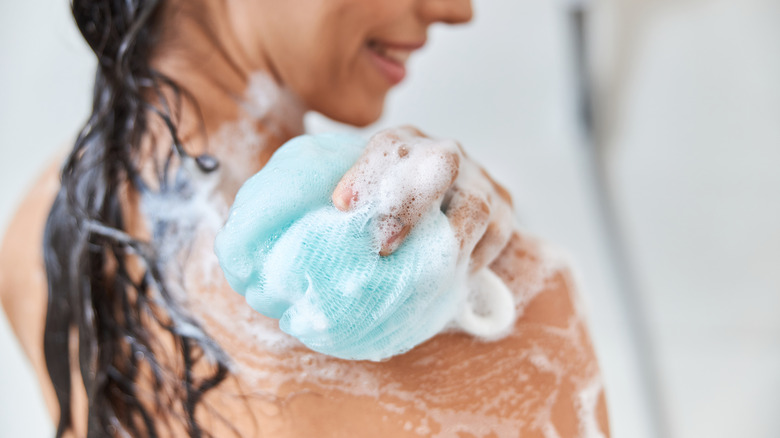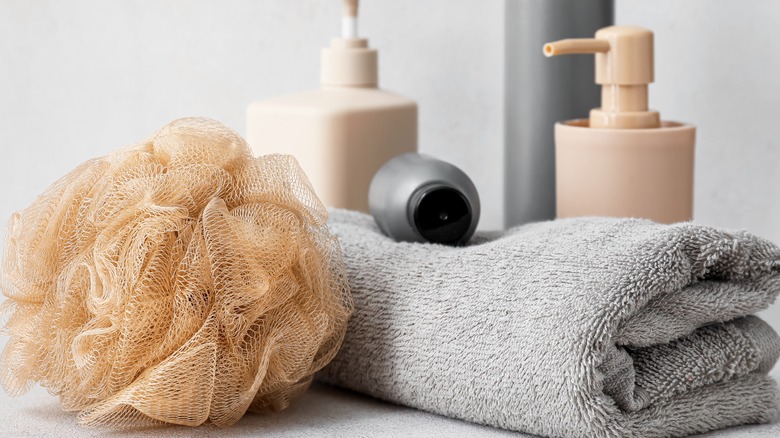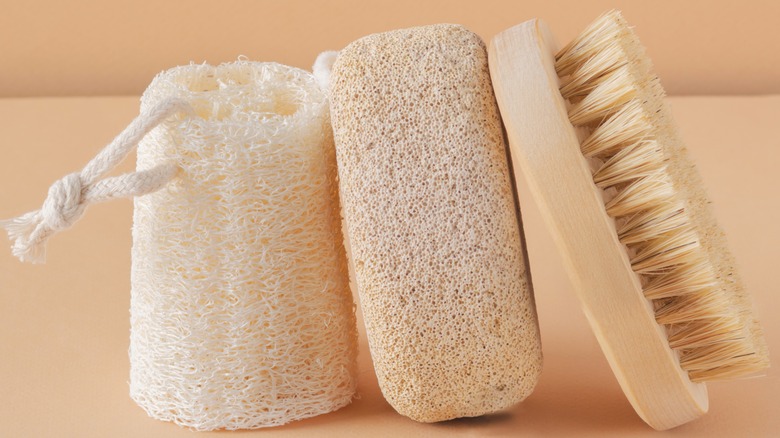How Often Should You Be Changing Your Shower Accessories?
When it comes to shower accessories, we usually don't think about how often we need to clean them, let alone replace them. Considering they're hanging out in the shower getting water and soap on them, it almost feels like a silly notion. But wait a minute, remember that little thing called bacteria? You may think that your loofah is clean as a whistle. But, in fact, it's a bacteria party and you're the guest of honor. And it only takes about 10 days for those germs to start multiplying at a terrifying rate (via Well + Good).
Yikes. And considering we're still in the throes of Covid, the last thing we need is to create more breeding grounds for bacteria. "Washing any object with soap — whether it be a shower tool, a toy or your own hands — would disinfect and neutralize the majority of organisms and pathogens on the surface," Stanford infectious disease physician Sudeb C. Dalai tells HuffPost. "[But] the shower tools, then left damp and hanging, would begin to 're-colonize' with a multiplication of any bacteria that are present or nearby on adjacent surfaces."
So the loofah definitely needs to be swapped out, but it's not the only thing. Here's a list of every shower accessory you should be changing regularly.
Shower curtain, bath mat, toothbrush
Although you can get more use out of some bath accessories — like towels — before needing to replace them, the same can't be said for other items. According to BuzzFeed, your shower curtain, bath mat, toothbrush, and toothbrush holder shouldn't be around more than three months to six months (tops!) before they're replaced with new ones. And not only that; all of these items should be cleaned once a week.
The rationale behind this? The bathroom gets a lot of use, and the moisture that builds in it wreaks havoc because items aren't able to dry completely. "Desiccation kills organisms and prevents their growth," microbiologist Philip M. Tierno told BuzzFeed. Without it, say hello to germs.
Also, and try not to lose your lunch over this one, there's the poop factor. In news you never ever wanted to know, fecal coliform bacteria can make its way onto your toothbrush — as well as other bathroom accessories — when the toilet is flushed (via American Dental Association). While this poop bacteria hasn't been found to negatively affect one's health, at the end of the day, it's still poop bacteria and it's going in your mouth and getting rubbed on your body via your loofah or towel. Just something to keep in mind.
Loofahs, razors, shower puffs, body brushes
When it comes to things you rub on your body, you want to ditch them after one to three months. If any of these items happen to be made of plastic or other man-made material, you can get closer to the three-month cut-off. But if these things happen to be made of natural material, you shouldn't go more than one month without getting new ones (via DailyMail.com). With these accessories, we're not just dealing with bacteria growth from moisture in the bathroom, but also bacteria that comes off our skin and makes a home on these items.
There is a good way to keep your shower accessories as clean as possible. "I recommend thoroughly washing [shower body accessories] after each shower/use with antibacterial soap or vinegar," board-certified dermatologist Rina Allawh told HuffPost. "If you don't have either at home, you can use diluted bleach and soak the loofah for at least five minutes."
The main point is, just because an item is being used to clean another regularly, that doesn't mean it's clean itself. And while having a little bacteria on your shower accessories isn't the end of the world and certainly won't kill you, it can cause unpleasant side effects. For example, if mold grows, those that are allergic can have issues with headaches and sneezing (via BuzzFeed). So if you know you haven't changed your loofah since Trump was in office, then you might want to get on that today.


